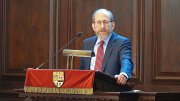This magazine’s John Harvard’s Journal section for July-August 2020—the first issue produced remotely, during the onset of COVID-19—began with a two-page spread on Massachusetts Hall, the University’s oldest building, at its 300th anniversary. It embodies what most people envision when they think of the campus: a free-of-frills early Georgian design, of mellow red brick with white trim. A brief text recounted the beloved building’s far-from-placid history, replete with renovations, wholesale changes of use, and a 1924 fire (a metaphor for passages through change and through storm). Assisted by the peerless Harvard University Archives staff, who exhumed plans for the structure, correspondence about paying for it, and physical evidence (the spikes that held it together, bricks), we had intended to report much more extensively. But one thing after another intervened—the pandemic precluded revisiting the archives for photographs, and after that, the right opportunity never arose.
Fortunately, a University nearing its 400th birthday presents boundless opportunities for commemoration, and so we turn to perhaps the least iconic old part of Harvard Yard (or at least its environs). That would be Wadsworth House, the yellow clapboard building whose front door, once facing a rural expanse, now dumps smack onto Massachusetts Avenue across from the looming bulk of Josep Lluís Sert’s Smith Campus (née Holyoke) Center. In the context of brick-everything Harvard, Wadsworth is something of an ugly—or at least odd—duckling, but it too has a claim on the collective memory. When it reopens this autumn, after a stem-to-stern renovation, it will be on the cusp of its 300th year, too.
In Harvard: An Architectural History (1985), Bainbridge Bunting observes that “the provincial legislature celebrated the appointment of conservative President Benjamin Wadsworth (1725-1737) by building him an official residence…planned on a generous scale,” a beneficence unimaginable today. (He goes on to note that “the committee overseeing construction ignored the legislature’s authorization of £1000…The final cost was almost twice that appropriated.” It’s an outcome that sounds familiar, even routine, to the modern observer of Crimson construction.)
The original layout included a barn, outhouses, and a pasture, per Bunting: “The president’s field comprised a good part of what is now the Old Yard; when this area was mowed, it was the responsibility of the freshman class to rake the hay.” Out front was a “pleasant garden with a paved courtyard,” lost to subsequent enlargement of what was then Braintree Street and is now Massachusetts Avenue. Presidents resided there for more than a century. It became University office space in 1950 (at one time housing the Harvard Alumni Association and this magazine).
Bunting does not report two other parts of Wadsworth House’s past—but their ghosts very much resonate today.
To Harvard’s credit, spurred by student researchers under the guidance of Bell professor of history Sven Beckert, the University in 2016 affixed to the clapboards a stone tablet acknowledging the four enslaved people who lived there when Presidents Wadsworth and Edward Holyoke (1737-1769) were in residence: Titus, Venus, Juba, and Bilhah.
Six years post-Holyoke, another notable event transpired there. On July 2, 1775, when General George Washington arrived to assume leadership of the Continental Army, he made the house his headquarters. His residence was brief—a couple of weeks—but eventful. From there, he took command of the troops (on Cambridge Common). And Washington apparently convened his first Council of War at Wadsworth and met there, among others, with Abigail Adams.
Both of these latter bits of history merit reflection today. At a time when some find it fashionable to denounce Harvard as apart from, or even alien to, its home country, it is worth remembering that the University was present at the creation, even before there was a United States of America, and has remained embedded in the nation’s well-being for the duration. In widening its vision to encompass all of its own legacies, including community members’ enslavement of other human beings, the modern Harvard has done another small bit to bring Veritas to the American story writ large.








